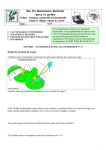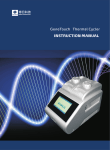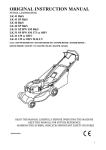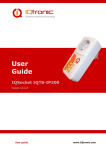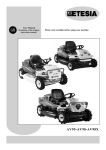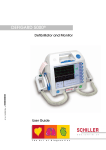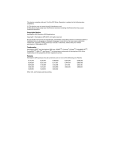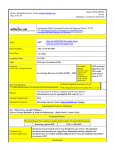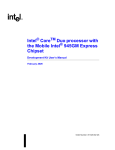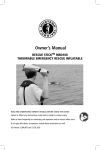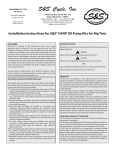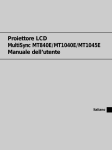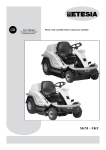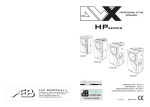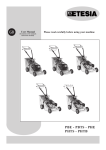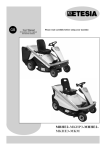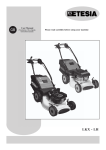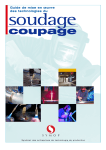Download Etesia Hydro 100D Hydro 124P owners operators manual to
Transcript
GB User Manual (Translation of the originals instructions manual) Please read carefully before using your machine BLSP-BLHP-BPSP-BPHP-BLSPB -BLHPB-BPHPX-HVSP-HVHP -HVHPX-BVHP Contents (BLSP-BLHP-BPSP-BPHP-BLSPB-BLHPB-BPHPX-HVSP-HVHP-HVHPX) 1. Your safety and that of others........................................................................................................................................................ 3 2. Key to diagrams............................................................................................................................................................................. 4 3. Illustrations ( BLSP - BLHP - BPSP - BPHP - BLSPB - BLHPB - BPHPX ).............................................................................. 8 3. Illustrations ( HVSP - HVHP - HVHPX )................................................................................................................................... 10 4. Pictures........................................................................................................................................................................................ 12 5. Pictures accessories in option...................................................................................................................................................... 17 6. Technical specifications............................................................................................................................................................... 18 7. Operating instructions.................................................................................................................................................................. 20 8. Accessories in option................................................................................................................................................................... 23 9. Assembly - Disassembly - Access to components....................................................................................................................... 26 10. Maintenance................................................................................................................................................................................. 28 11. Prolonged storage - winter storage.............................................................................................................................................. 33 12. Troubleshooting .......................................................................................................................................................................... 33 13. Malfunctions and their remedies................................................................................................................................................. 34 14. Maintenance schedule . ............................................................................................................................................................... 35 15. Warranty....................................................................................................................................................................................... 39 C ONGRATULATIONS ! You are now the proud owner of an Etesia ride-on mower! This extremely reliable and tough machine has been specially designed to give many years of service. • In order to prolong the life of your mower and keep it in excellent working order, read this manual carefully and always follow the safety recommendations and maintenance instructions. • For this reason, your model may differ slightly from the description in this manual. • Up-to-date technical information can be obtained from your dealer who will be happy to resolve any queries you may have. Mower Identification • The identification number of your mower is located on the central bonnet (picture 1 page 5). • Always quote this number when seeking advice from your dealer. • As part of our commitment to excellence, we are constantly seeking new ways of improving our products. 1• Your safety and that of others • Always follow these instructions when using your ride-on mower. • No responsibility will be accepted by the manufacturer in the event of failure to comply with this manual or with current regulations. • Prior to use, check that safety labels are present on the mower as indicated in the manual. Read these labels carefully. If any safety labels are missing, inform your dealer immediately, as the mower is required by law to carry them. • Never remove warning labels or safety instructions. • Before using your mower, make sure that you are completely familiar with the controls. • Study the operating instructions so that you are able to stop the machine quickly. • Always keep the mower and accessories in good working order • Never operate the mower using faulty guards or without the use of safety devices. • Never attempt to adjust your ride-on mower without the prior approval of the manufacturer. • Do not attempt to adjust the engine speed controls. • Never race the motor as this will increase the risks of injury to the operator and the likelihood of damaging the components of your lawn mower. • Never allow your mower to be used by anyone who is not familiar with the operating manual. • Always drive the machine at very low speed in forward or reverse when the grassbox is in high position. • Never use your mower on slopes with a gradient of more than 10° (17,6%). • Always observe the special instructions concerning use of the mower on sloping ground. • Never drive your mower too close to embankments or ditches, on soft ground, or where there is a risk of overturning. • The user is responsible for ensuring the safety of others within the area where the mower is being used. • Keep a safe distance from people and animals when the engine is running. • Never allow passengers to ride on the mower. • Never allow children under the age of 16 to drive the mower. • Always remove the ignition key when leaving the mower unattended, even momentarily. • Before using the mower, always check the condition and adjustment of the blade. • Never attempt to carry out work on or underneath the mower if it has been raised on temporary supports or without taking proper safety precautions. • Before mowing, always clear the lawn of stones, pieces of wood or metal, wire, bones, plastic, branches and other debris liable to be thrown out by the mower. • Low branches liable to cause injury to the user should also be removed. • Avoid obstacles such as mole hills, concrete pedestals, tree stumps and edging, which cannot be cut by the blade and which could damage the cutting mechanism specially the blade. • Change absolutely the blade after any shock. • Exercise particular care when reversing. • Never place hands or feet under the cutter housing. • Whilst mowing, take care to avoid injury to others caused by flying stones and other objects. • Operate the mower only in broad daylight or with good artificial lighting. • Loose clothing and short trousers should not be worn when using the mower. • Always wear stout and closed shoes. • When adjusting the engine or moving parts, always switch off the engine and remove the ignition key. Use the circuit-breaker to turn off the electric supply. Close the hand brake. • Never operate the machine when feeling tired or unwell. • Never operate the machine after consuming alcohol or taking medicine. • When the mower is driven on surfaces other than grass, disengage the cutter and switch it to the fully raised position. • Do not fill the tank whilst the engine is running. Allow the engine to cool for few minutes before filling. • Do not use your ride-on mower on public roads • To tow loads, use only tow bars bearing the reference of ETESIA: MRD100. LIABILITY • The indications given in these instructions must be followed. For further information, contact your ETESIA dealer. • ETESIA shall have no liability if the instructions or applicable regulations are not followed. • As ETESIA strives to make continuous improvements of its products, the company reserves the right to change the specifications of the presented models without advance notice. The photos and illustrations are not contractual. • WARNING: fuel is highly flammable. - Always fill the fuel tank in the open and do not smoke during this operation. - Add fuel before starting the engine. - Never remove the fuel cap whilst the engine is running or hot. - If diesel is spilt, do not attempt to start the engine: remove the mower from the affected area and take care not to ignite any undispersed diesel vapour. • Ensure that the fuel tank and fuel can caps are replaced correctly. • Never store, pour or use petrol near a naked flame or near devices such as stoves, water-heaters with pilot lights or any other device liable to produce sparks. • WARNING : NEVER ALLOW THE ENGINE TO RUN IN CONFINED AREAS. Exhaust gases contain carbon monoxide, which is odourless and can kill. • Do not start the engine if you can smell petrol, or in the presence of other risks of explosion. • To avoid any burn, do not touch the exhaust pipe when it is hot. 2• Key to diagrams - SAFETY • Labels Diagrams rectangle B (picture 2) • Various labels have been affixed to your mower. • Check that they are all present (see list below and photos). • Labels with a yellow background warn against risks. • The other labels contain instructions for operating the mower. • a = Risk of the machine toppling over. • SAFETY • DANGER! - Never place hands or feet under the cutter housing. - Keep a safe distance from others when mowing. This symbol appears in the instruction manual alongside those sections which deal with user safety. This symbol appears in the instruction manual alongside important information on how to prolong the life of your mower. Safety labels Diagrams rectangle A (picture 2) (BLHP - BPHP - BLHPB - BPHPX - HVHP - HVHPX). • b = Do not drive with the grassbox raised. • c = Do not top-empty on slopes of more than 8°. • d = Do not top-empty on bankings of more than 8°. Diagrams rectangle C (picture 2) (BLSP - BLHP - BPSP - BPHP - BLSPB - BLHPB - BPHPX - HVSP - HVHP - HVHPX). • a = Risk of cutted feet and hands. • b = Hold the third persons far from the machine. Diagrams rectangle D (picture 2) (BLHP - BPHP - BLHPB - BPHPX - HVHP - HVHPX). Caution! Do not lift the machine using the top-emptying hoop. Marking of accumulators (BLSP - BLHP - BPSP - BPHP - BLSPB - BLHPB - BPHPX - HVSP - HVHP - HVHPX). (BLSP - BLHP - BPSP - BPHP - BLSPB - BLHPB - BPHPX - HVSP - HVHP - HVHPX). • a = CAUTION ! • a = Indicates that these hazardous products which should preferably be returned to the distributor. • b = Before using, please read and follow the safety and maintenance instructions of the instruction booklet. • c = Stop the engine, remove the ignition key and disconnect the battery terminals before carrying out any maintenance operation or repairs. • d = Risk of projections. • e = Avoid the presence of third persons in the danger zone. • f = Fall down risk. Never transport passengers. • g = Hold the third persons far from the machine. • h = Risk of toppling over the machine. • i = Never use your ride on mower on slopes with a gradient of more than 17,6% (10°). • b = (Pb) indicates the presence of lead. • c = Indicates the year of entry into service of the machine. 2• Key to diagrams - SAFETY 1 a 2 b c 2 2• Key to diagrams - SAFETY RECTANGLE A ( BLSP - BLHP - BPSP - BPHP - BLSPB - BLHPB - BPHPX - HVSP - HVHP - HVHPX ) RECTANGLE B ( BLHP - BPHP - BLHPB - BPHPX - HVHP - HVHPX ) RECTANGLE C ( BLSP - BLHP - BPSP - BPHP - BLSPB BLHPB - BPHPX- HVSP - HVHP - HVHPX ) a b Marking of accumulators RECTANGLE D ( BLHP - BPHP - BLHPB BPHPX- HVHP - HVHPX ) a c b 2• Key to diagrams - USE • ENGINE SPEED • CUTTING POSITION Indications for the control of the engine speed MAX: Engine at full throttle Indication in mm of the cutting position (on hard, flat ground) MIN: Engine at idling speed • ENGINE START 0: Engine off, electrical circuit power off 1: Electrical circuit power on, engine pre-heating • DIRECTION INDICATOR Indication of direction change, left Start engine Indication of direction change, right Knob pulled out, position for starting with cold engine (for HVSP, HVHP, HVHPX) • PARKING BRAKE To put on the parking brake, move the lever backwards. To release the parking brake, move the lever forwards. • BY-PASS 1: Position hydraulic power system engaged 0: Position hydraulic power system disengaged • OPENING / CLOSING THE GRASSBOX Lever up: the grassbox opens Lever down: the grassbox closes Lever up: the front lift goes up Lever down: the front lift goes down • RAISING / LOWERING THE GRASSBOX • HORN • SAFETY INDICATOR Safety indicator indicating that it is safe to move the machine (except HVSP - HVHP - HVHPX) Safety indicator indicating that it is safe to engage the blades • WARNING LIGHTS • SIGNALLING Lights on Sidelights (on rotary switch) Dipped headlights (on rotary switch) Lever up: the grassbox goes up Lever down: the grassbox goes down Driving lights (on rotary switch) Lever up: tilts to the right Lever down: tilts to the left Engine pre-heating warning light (except HVSP HVHP - HVHPX) • DIFFERENTIAL (except BPHPX and HVHPX) The arrow indicates the direction of movement to block the differential. • STARTING THE CUTTING UNIT Engine oil pressure warning light Coolant temperature warning light. A warning buzzer is combined with this light (except HVSP - HVHP - HVHPX). Battery charge warning light (except HVSP - HVHP - HVHPX) I: cutting unit rotating Hydraulic oil overheating warning light 0: cutting unit stopped Low fuel level warning light 3• Illustrations ( BLSP - BLHP - BPSP - BPHP - BLSPB - BLHPB - BPHPX ) 5 4 7 6 8 9 10 3 2 11 12 1 24 13 14a 16 15 17 19 18 14b 20 25 23 22 a 21 a 30 26 27 28 29 31 3• Illustrations ( BLSP - BLHP - BPSP - BPHP - BLSPB - BLHPB - BPHPX ) 1. 2. 3. 4. 5. 6. 7. 8. 9. 10. 11. 12. 13. 14. 15. 16. Maintenance cycle counter Engine pre-heating warning light Lights on indicator Continuous fuel level indicator Hydraulic circuit overheating warning light Battery load warning light Safety light, while moving machine Engine temperature warning light (cooling liquid) Engine oil pressure warning light Diesel low level warning light Engine temperature indicator Blade clutch safety light Hour counter Fuel tank filler cap Warning lights switch Cutting unit control switch 17. 18. 19. 20. 21. 22. 23. 24. 25. 26. 27. 28. 29. 30. 31. Differential lock control switch (except BPHPX) Engine speed control lever Forward drive pedal Reverse pedal Ignition key Indicator control switch Horn button. Sidelights, and headlights schwitch. Engine cover lock Parking brake lever Grassbox opening/closing lever High lift emptying lever (BLHP - BPHP - BLHPB - BPHPX) Cutting height adjustment lever Lifting jacks (BLHP - BPHP - BLHPB - BPHPX) Seat adjustment lever (longitudinal) Circuit-breaker 3• Illustrations ( HVSP - HVHP - HVHPX) 12 10 3 9 5 4 13 24 14 1 15 17 32 19 18 20 25 23 22 a 21 16 a 30 26 10 27 28 29 31 3• Illustrations ( HVSP - HVHP - HVHPX) 1. 3. 4. 5. 9. 10. 12. 13. 14. 15. 16. 17. 18. 19. 20. Maintenance cycle counter Lights on indicator Continuous fuel level indicator Hydraulic circuit overheating warning light Engine oil pressure warning light Diesel low level warning light Blade clutch safety light Hour counter Fuel tank filler cap Warning lights switch Cutting unit control switch Differential lock control switch (except HVHPX) Engine speed control lever Forward drive pedal Reverse pedal 21. 22. 23. 24. 25. 26. 27. 28. 29. 30. 31. 32. Ignition key Indicator control switch Horn button. Sidelights, and headlights schwitch. Engine cover lock Parking brake lever Grassbox opening/closing lever High lift emptying lever (HVHP - HVHPX) Cutting height adjustment lever Lifting jacks (HVHP - HVHPX) Seat adjustment lever (longitudinal) Circuit-breaker Choke pull-knob 11 4• PICTURES 1 2 3 4 5 6 12 4• PICTURES 1 2 3 b 7 8 a f c e a b b 10a 9 9a a 11 10b b a MAXI MINI a MINI 12a 12b 12c 13 4• PICTURES b b a a a 13a 13b 15b 15a 14 15c a a a 16b 16c 16a d a a c b 19 18 17 a a 21 20 14 22 4• PICTURES a 23 a 24a 24b a a 24c 25 26 c b a 27 28a 28b a a 29 30 28c 31 15 4• PICTURES 5 c b a 33 a 32 35 34 36 a c a 37 38 b 39 16 5• PICTURES accessories IN OPTION 1 2 3 4 5 6 17 6• TECHNICAL Specifications MODELS BLSP-BLHPBLSPB-BLHPB BPSP-BPHP-BPHPX LOMBARDINI 702 FOCS PERKINS 403007 BRIGGS & STRATTON 38677011261 Diesel 2 cylinder Diesel 3 cylinder 4 Stroke - OHV, 2 V-cylinder at 90° Bore x stroke 75 x 77.6 mm 67x72 mm 75,5x70,0 mm Cubic capacity 688 cm 3 760 cm 3 627 cm 3 Diesel (French administrative horsepower) or Biofuel B30 Diesel 95 Unleaded fuel 18 CV 20,5 CV 23 CV By oil pressure By oil pressure By oil pressure All-year cooling liquid All-year cooling liquid Air ENGINE Type Fuel type Power at 3600 rpm Lubrication Cooling Starter motor HVSP HVHP HVHPX Electric 12 V Electric 12 V Electric 12 V Ext.12V-33 A with regulator External 12V-40 A with regulator 12V-16A with regulator 12V-60A 12V-60A 12V-60A 12,5 V 12,5V Standard 14x19mm special 16mm on flat Engine oil filter Cartridge 20 µm Cartridge Cartridge Diesel filter Cartridge 2-3 µm Cartridge Diaphragm pump - Filter 7,5 µm Engine air filter MANN+HUMMEL with Cartridge MANN+HUMMEL with Cartridge Foam filter + paper cartridge Operating speed 2750 rpm ± 20 2900 rpm ± 20 2900 rpm ± 20 1.6 l + 0,2 l for the oil filter 3.05 l with filter 1,36 l - 1,42 l 14.5 l 14.5 l 14.5 l 1 Day (depending on conditions) 1 Day (depending on conditions) 1 Day (depending on conditions) Alternator Battery Type of heater plug Engine oil sump capacity Fuel tank capacity Range with a full tank DRIVE TRANSMISSION Hydraulics Reversible variable delivery piston pump Geroler engine in the rear wheels Differential lock Hydraulic by flow divider Forward / reverse speed : 0 to 12 Kmph Hydraulic tank capacity 20 l Hydraulic tank air filter 10 µm Hydraulic oil filter (cartridge) TRACTOR 25 µm abs BLSP - BLSPB BLHP - BLHPB BPSP BPHP BPHPX HVSP HVHP HVHPX tot :567-fr :237 /re:330 tot :638-fr:237 /re :401 tot:574 fr:250/re :324 tot:645-fr:250 /re :395 tot:702-fr:279 /re :403 tot:514-fr:201 /re :313 tot:585-fr:201 /re :384 tot:636-fr:230 /re :406 Dimensions (L x l x h) with grassbox 2920x1050 x1290mm 2920x1050 x1730mm 2920x1050 x1290mm 2920x1050 x1730mm 2920x1050 x1730mm 2920x1280 x1290mm 2920x1280 x1730mm 2920x1280 x1730mm Dimensions (L x l x h) with deflector 2600x1050 x1290mm 2600x1050 x1730mm 2600x1050 x1290mm 2600x1050 x1730mm 2600x1050 x1730mm 2600x1280 x1290mm 2600x1280 x1730mm 2600x1280 x1730mm Weight empty (Kg) Front track width 970 mm Rear track width 980 mm Wheel base 1360 mm Chassis Mechanically welded tubular, high-clearance type Steering Hydraulic-orbitrol system and single rod double-acting jack Tyres Radius of non-mowed surface front : 16x6.5x8 / pressure : 1.2 bars / rear : 23x8.5x12 / pressure : 1.2 bars 1.1 m Dynamic brake Hydraulic with drive transmission Parking brake Drum brakes on rear wheels 18 6• TECHNICAL Specifications BLSP-BLHP-BLSPB-BLHPB BPSP-BPHP-BPHPX HVSP HVHP HVHPX MOWING SYSTEM Cutter housing Opposed double volute - in cast aluminium Type of assembly Opposed double volute - in cast aluminium Opposed double volute Suspended plate Number of blades 2 2 Direction of rotation 2 Blades of 65cm - Covering of 6cm Opposite Blade clutch Electromagnetic with brake incorporated Blades protection (from impacts) Cutting width Shearing screws 100cm 100cm Cutting height 124cm Choice of 6 positions: 44-54-66-78-90-102mm Ejection Rear central directly into the grassbox direct ejection Anti-scalp system 2 rollers (front and rear) 2 rollers (front and rear) 2 anti-scalp rollers (front and rear) GRASS COLLECTION SYSTEM Grassbox capacity Approx 600 L Structure Tubular-canvas treated anti-UV Grassbox emptying BLSP-BLSPB : hydraulic to ground level BLHP-BLHPB : hydraulic at heights up to 1.80m SAFETY SYTEM hydraulic to ground level hydraulic to ground level or at heights up to 1.80m Operator presence contactor (seat) Grassbox / deflector presence contactor BLADES NOISE LEVEL VIBRATION BPSP : hydraulic to ground level BPHP-BPHPX : hydraulic at heights up to 1.80m Whole body Upper limbs MZ102D (right) MZ102G (left) MZ102D (right) MZ102G (left) MZ124R (right) MZ124L (left) Sound pressure level at driver’s position 85 dB(A) Sound pressure level at driver’s position 85 dB(A) Sound pressure level at driver’s position 90 dB(A) Directive 2006/42/CE, Standarts reference EN836, EN1032, EN1033 : ahw=0,82 m/s² Directive 2006/42/CE, Standarts reference EN836, EN1032, EN1033 : ahw=0,82 m/s² Directive 2006/42/CE,Standarts reference EN836, EN1032, EN1033 : ahw=0,79 m/s² Directive 2006/44/CE,Standarts reference ISO26311, ISO 5349-1+2 : 1,4 awx - 0,42 m/s² ; 1,4 awy - 0,72 m/s²; awz - 0,57 m/s² Directive 2006/44/CE, Standarts reference ISO26311, ISO 53491+2 : 1,4 awx - 0,42 m/s² ; 1,4 awy - 0,72 m/s²; awz - 0,57 m/s² Directive 2006/44/CE, Standarts reference ISO26311, ISO 53491+2 : 1,4 awx - 0,41 m/s² ; 1,4 awy - 0,73 m/s²; awz - 0,51 m/s² Values of exposure day laborers : A(8) - 0,72 m/s² on 8 hours Values of exposure day laborers : A(8) - 0,72 m/s² on 8 hours Values of exposure day laborers : A(8) - 0,73 m/s² on 8 hours Directive 2006/42/CE, Standarts reference EN836, EN1032, EN1033 : ahw=4,7 m/s² Directive 2006/42/CE, Standarts reference EN836, EN1032, EN1033 : ahw=1,83 m/s² Directive 2006/42/CE, Standarts reference EN836, EN1032, EN1033 : ahw=1,63 m/s² Values of exposure day laborers : A(8) - 4,7 m/s² on 8 hours Values of exposure day laborers : A(8) - 1,83 m/s² on 8 hours Values of exposure day laborers : A(8) - 1,63 m/s² on 8 hours 19 7• Operating instructions 7•1 PDI- Pre delivery inspection • Because this is a highly technical operation, the PDI of your ride-on mower is done by your ETESIA dealer. 7•2 Safety systems • The mower is fitted with 4 safety switches which are actioned by: 1. The drive transmission operating link (at drive pump level) 2. The rear part of the grassbox and/or the front of the grassbox (with lift-emptying) 3. The parking brake 4. The seat • Engine can only be started if: - The driver is sitting on the seat: the parking brake is on. - Both driving pedals are in neutral position. - The cutting unit is not engaged. • The engine stops if: - the operator leaves the seat without putting on the parking brake. - the operator leaves the seat with the cutting unit engaged. - the operator presses a drive pedal with the parking brake on. - the operator is driving too fast without the bin in the working position (with HVHP - HVHPX models only). • The cutting unit stops if: - the operator leaves the seat, - a grassbox emptying operation is on its way. • The cutting unit can only be started if: - the driver is sitting on the seat. - the rear part of the grassbox is in the closed position. - the grassbox is in the working position. Remark: if the blade engagement indicator (page 6 and 8, item 12) is on, you can start blades. CAUTION! Opening the grassbox stops the cutting unit. The cutting unit starts again as soon as the grassbox unit is back in the working position. • The machine only moves if: - the driver is sitting on the seat - the parking brake is off Remark: For all models except HVSP, HVHP and HVHPX, if the ‘safe to move machine’ indicator (page 6, item 7) is on, you can move the machine. 7•3 Fuel The engine uses diesel for the BLSP-BLHP-BPSP-BPHP -BPHPX models and/or Biodiesel B30 for the machines equipped with Lombardini motor. The engine uses 95 unleaded fuel for the HVSP, HVHP and HVHPX models. WARNING ! Use clean and fresh fuel. Handle the fuel with care. When filling the tank, use a funnel and wipe any fuel splashes immediately. Do not fill the tank with the engine running or when the engine is hot closed to a machine you are filling. Never smoke. Avoid any flames or sparks. • When filling the tank, please avoid fuel spilling. • If, in spite of these precautions, should some fuel spilled please: a) Clean all the contaminated parts scrupulously. b) Only restart the machine after you have checked that all spilt fuel has been eliminated. • Ensure that the fuel tank cap is screwed on tightly. • The tank must be emptied out of doors (in the open air); 20 NOTE: In cold weather, the viscosity of diesel increases and paraffin crystals form. This may affect the performance of the engine as its fuel supply is defective. In this case, use winter quality diesel, which can be used at temperatures as low as -20°C. • To avoid the poor running of the engine, after it has been polluted (condensation water, detritus), the fuel tank must be emptied every 1000 hours or once a year. 7•4 Longitudinal seat adjustment For maximum comfort, the seat can be adjusted (item 19 and 20, page 6 and 8). • To unlock the seat, lift the lever (item a, picture 30, page 6 and 8). • Move the seat into the position required. • Release the lever and check that the seat is blocked in position. Remark: The seat can be folded forward in order to keep it clean and dry. 7•5 Starting and stopping the engine Checks before starting • The machine is delivered ready for use. Nevertheless you should check: - the engine oil level (see paragraph 10 •1•1 page 26) - the oil level in the hydraulic tank (see paragraph 10 •2•1 page 28). We ask you as well to fill up with fuel before using for the first time. • Check that all the safety labels are stuck on the machine (page 3). Be particularly sure to follow the instructions in paragraph 1 Your safety and that of others (page 1). 7•5•1 Starting BLSP-BLHP-BPSP-BPHP-BLSPB-BLHPB-BPHPX • Sit on the seat. • Ensure that the cutting unit start/stop switch is in the stop position • Put on the parking brake • Place the engine speed control lever on the [medium] position Do not press on the drive pedals. • Turn the ignition key to position 1 (power on and pre-heating). • As soon as the pre-heating indicator light goes out, turn the ignition key to the start position . • Never turn the key for more than 4 seconds. • The engine is running, release the key and bring the engine speed control lever back to the min. position. • Let the engine run for a few minutes before changing to full throttle and starting the cutting unit. HVSP - HVHP - HVHPX • Sit in the seat. • Make sure that the cutting system start and stop switch is in the off position. • Engage the parking brake. • Set the engine speed controller to the [maxi] position. • Pull on the choke control if the engine is cold. • Turn the ignition key to the starting position . • As soon as the engine turns over, release the key and set the throttle control between the [mini] and [maxi] positions. • Push in the choke knob. • Let the engine run for a few minutes before changing to top speed to turn on the cutting system. 7• Operating instructions CAUTION! Do not change the original engine settings; do not increase the engine speed as this risks to increase the hydraulic flow and damaging parts of the hydraulic circuit. CAUTION! Do not place hands or feet on any moving parts.The exhaust gases are toxic, do not leave the engine running in a closed space. 7•5•2 Stopping the engine • When necessary, stop the cutting unit. • Put on the parking brake. • Bring the accelerator lever to the [MIN] position. • Switch off the ignition by placing the key in the [0] position. CAUTION! When the machine is not in use or is left unattended, remove the ignition key. 7•6 Drive pedals • The drive controls take is ensured by of two pedals located on the right of the footboard. • The exterior pedal is for forward, the interior pedal is for reverse. Each pedal is marked with an arrow indicating the direction of movement of the machine (item 19 and 20, page 6 and 8). • These pedals control the speed of the mower’s movement (from stationary to maximum speed), but also the dynamic braking. • When you release the pedal, the mower is progressively braked until it stops completely. 7•7 Differential lock (ALL MODELS except BPHPX and hvhpx) • Differential lock is a device that re-establishes drive on the two rear wheels in the event of one of them losing adherence (wheel spin). To engage it, press the switch (item 17, page 6 and 8). 7•8 Starting and stopping cutting unit (blades) 7•8•1 Starting • Place the throttle control on the [MAX] position (item 18, page 6 and 8). • Flip the cutting unit start switch forward to the cutting unit [engaged] position (item 16, page 6 and 8). • The cutting unit can only be started if the user is sitting on the seat and the grassbox is in its working position with the rear part closed. 7•8•2 Stopping • To stop the cutting unit, flip the switch backward into the [0] position. • Opening the grassbox (or lifting it) will stop the cutting unit (blades). • They will start again as soon as the grassbox is in the working position (box closed and in the low position). 7•9 Driving the mower • Release the parking brake. • Slowly press the right-hand side pedal to move the mower forward or on the left-hand side pedal to go reverse. • Choose the driving speed corresponding to a satisfactory quality of cut. • You will not obtain a nice cut if the drive speed is too high or if the rotation speed of the cutting unit (blades) drops under the effect of an overload. • To get the best results, always keep the engine at full throttle when mowing. • When you are mowing on a slope or in long grass, if the engine speed drops, do not press harder on the drive pedal. Reduce the drive speed, rather. The pedal does not serve to adjust the engine speed - it is not an accelerator. CAUTION! To stop the mower rapidly, take your foot off the drive pedal and activate the parking brake. • During traveling without mowing, always stop the blades from turning. • If you activate the pedal with the parking brake on, the engine stops. 7•10 Cutting height adjustment (6 positions) • Move the lever down to lower the cutter housing, and up to raise it. • Use a high setting for tall and wet grass (position 4 (78), 5 (90) and 6 (102)). • Only use the lower settings for smooth, regularly maintained lawns. CAUTION! For this operation, the operator must be sitting on the seat and other people kept away from the mower as there is a risk of their feet being crushed. 7•11 Installation of the rear part of the grass collection system • The grass collection system is made of of two parts: the front part fixed on the mower (BLSP-BPSP-BLSPB-HVSP), or on the lifting arms (BLHP-BPHP-BLHPB-BPHPX HVHP-HVHPX) and the rear part. • The rear part is installed as follows: - If it is not already in place, position the flap control rod (see picture 2 page 10). - Bring the rear part up to the front part. Rest in on the supports provided for this purpose (see picture 3 page 10). - Connect the 2 flap connecting rods onto the rear part (see picture 4 page 10). - Lock the rear part of the grassbox onto the front using the handles (see picture 5 page 10). - Fix the two jacks to the grassbox aligning the ends of the jacks with the ball joints situated on the sides of the rear part (see picture 5 page 10). • To remove the rear part, carry out the operations in reverse order. 7•12 Mowing with grass collection The picture 1, page 12 shows the optimum way of using the mower on most lawns. • These indications allow you to avoid tight turns and unnecessary movements. • When you are mowing with a low cutting position, you must use a slow speed, to ensure optimum grass collection. • Before mowing, check the blades conditions. That have to be tight and in the correct position. See paragraph 10•5 – Maintaining the cutting unit, page 30. • Before starting to mow you must also check that the grassbox is attached correctly. • To obtain a regular cut, it is important to check if the front and rear tyre pressures correspond to the pressures recommended (front pressure: 1.2 bars – rear pressure: 1.2 bars). 21 7• Operating instructions Emptying the collection system Do not empty the box on slopes of more than 8°. Emptying is done from the driver’s post. - BLSP-BPSP-BLSPB-HVSP: Move the control lever backwards (item 26, page 6 and 8), then move the mower forward slightly before closing the rear part again in the working condition by moving the lever forward. - BLHP-BPHP-BLHPB-BPHPX-HVHP-HVHPX: Move the lefthand control lever backwards (item 27, page 6 and 8). • Hold this position until the grassbox is at the height required (1.8m max). Then move the right-hand control lever backwards (item 26, page 6 and 8) until the rear part of the grassbox is completely open. • Do this in reverse order to return the collection system in the collection position. NOTE: Only drive or move the machine with the grassbox raised at extremely low speeds, whether forward or in reverse. Avoid accelerating and changes of direction (FW – REV), as well as sharp braking. CAUTION! In the event of a leak, hydraulic fluid can have sufficient force to penetrate the skin and cause serious injury. Medical assistance must be sought immediately. 7•13 Driving on slopes • The machine must only be used on terrain with a slopes of less than 17.6 % (10°). • Always respect the mowing scheme shown in picture 1, page 12. •To drive on a slope with a maximum of safety, follow the indications below: - Avoid sudden starts. - Always drive at low speed on slopes, to avoid to lose control of the mower. - When beginning to move the machine up or down a slope: - Release the parking brake and immediately set the mower in motion using the drive pedals. - Be particularly careful when turning round on a slope. Prepare yourself for the change of direction and reduce speed in order to avoid losing control of the mower. - Be careful of holes, bumps and other hidden hazards. - As soon as the machine stops, put parking brake on. 22 7•14 Lights The sidelights, dipped headlights and driving lights are controlled by the rotary switch (item 23, page 6 and 8). • Your machine is equipped with the MX102N lighting kit (picture 2, page 15) and may therefore be approved in different countries. Contact your dealer for details of how to proceed. • Check that all the lights are working before driving on public roads. • The lighting supplied on your ride-on mower is only intended for movements. It is not suitable for night working, unless you work in good artificial lighting. 7•15 Parking brake (item 25, page 6 and 8) To put on the parking brake, pull the lever backwards. To release it, first unlock the mechanism using the manoeuvre button (a). 8• Accessories in option Ensure you follow the mounting instructions supplied with each option. REMARK: if you do not have the skills or equipment necessary to install your options yourself, please contact your dealer. MU100D: Mulching kit (All models except HVSP, HVHP, HVHPX) • Mulching allows you to mow without collecting grass, leaving the cut grass on the ground instead (see picture 5, page 17). MTAD10 (All models except HVSP, HVHP and HVHPX) • This is an accessory interface (see picture 6, page 17) necessary for the use of some accessories. To be fitted according to the table on page 22. MDD100 Mowing with a deflector (see picture 3, page 17) • The deflector must be fitted if you wish to work without the grass collection system, otherwise the cutting system cannot be started. • A first pass at reduced speed and at maximum cutting height will clear the area to be mowed. For a nice finish, do a second pass at the final cutting height. • The MDD100 deflector allows the grass to be evenly spread across the width of the machine. MRD100 Towbar (see picture 4, page 15). There must be a two ball fitted to the towbar. Buy a ball through your retailer. • Do not use the mower on slopes terrain with a trailer. • Maximum authorised mass: 450 kg (trailer + contents) • Maximum authorised towbar load: 50 kg • Maximum tractive force: 100 kg CAUTION! Ensure that the force applied to the towbar is always directed downwards. Pay attention when pulling loads. Avoid making tight turns. • For the models BLHP-BLHPB-BPHP-BPHPX-HVHP-HVHPX: Assemble the locking pin delivered with the tow bar (item a, picture 26, page 13). MTS: Side brush for MT102N sweeper (All models except HVSP, HVHP and HVHPX) MU102: Box for manual emptying sweeper (All models except HVSP, HVHP and HVHPX) MET: Spreader • This option allows spreading of salt, sand or fertilisers. • It can be used at the same time as the front sweeper. MSD100 sweeper/snow blade bracket • This is an accessory interface necessary for the mounting of the snowplough (MV102) or the sweeper (MT102N). MX102N: Road approval kit • Rear lighting frame (see picture 2, page 15). MF100 G (MF100 D) Blades with left (right) flails (All models except HVSP, HVHP and HVHPX) • When an obstacle is hit, the flails fold back, then immediately return to the working position. MND100: Chain kit • Snow chain kit for the rear wheels. MCH100: Double distributor interface • Allows emptying at ground level or in height or: • lifting and forward tilting (sweeper, snow plough…) • This option is necessary for: - high lift system MHD100 - sweeper MT102N - snow plough MV102 M0102: Suspension for driver’s seat MHD100: Lift emptying system • The comfort of the seat can be improved using this suspension. It can be adjusted according to the driver’s weight. • This option facilitates the emptying of your grassbox directly into a trailer. OYD100: Cab MAS 100: ROPS arc • This cab, ideal for the winter season, will protect you from the snow and rain. • Visibility remains excellent in all directions. MYD10C: Heater (All models except HVSP, HVHP and HVHPX) • With the heater fitted, working conditions remain pleasant even when temperatures outside drop. • This is a rollover safety cage. MASP • This is an interface needed for installing the MAS 100 accessory on BLSP-BPSP-BLSPB and HVSP. MAC: Armrest MRM : Remorque multi-fonction MYD10L: Windscreen washer • With the windscreen washer, you will keep good working visibility. In certain countries this option is obligatory for road approval. MV102: Snow plough • This snow plough, with a working width of 1.25 m, has a tilting, hydraulically raised blade. It is also fitted with a scraper strip. MT102N: Sweeper (All models except HVSP, HVHP and HVHPX) • This sweeper is used to clean the ground, sweep leaves or snow. • It working width is 1 m. • The drive, tilt and lifting mechanisms are hydraulic. The speed of rotation of the brush is variable. • It is possible to pick up the sweepings using the box offered as option MU102. 23 8• Accessories in option BLSP BPSP BLSPB MF100D MF100G MZ102D MZ102G MC100D MC100G MDD100 MO102 MH600 MX102N MND100 MX12DN MU100D MAC MRD100 MCH100 MASP10 OYD100 MET OYD10C MRM MAS100 MHD100 MYD10L OYD10L MYD10C MSD100 MTAD10 MT102N Version : 12/2009 MV102 MTS MU102 INTERFACES REQUIRED FOR THE USE OF BLSP - BPSP - BLSPB - BLHP - BPHP - BPHPB - BPHPX ACCESSORIES BLHP-BPHP BPHPB-BPHPX MDD100 MF100D MF100G MO102 MH600 MZ102D MZ102G MC100D MC100G MX102N MX12DN MND100 MAC MU100D MRD100 OYD100 MAS100 MET OYD10C MRM OYD10L MYD10L MYD10C MSD100 MTAD10 MV102 MU102 24 MTS Version : 12/2009 MT102N 8• Accessories in option HVSP MDD100 MO102 MH600 MX102N MND100 MX12DN MAC MRD100 MCH100 MASP10 OYD100 MET MRM MAS100 MHD100 MYD10L OYD10L Version : 02/2011 MSD100 MV102 INTERFACES REQUIRED FOR THE USE OF HVSP - HVHP - HVHPX ACCESSORIES HVHP - HVHPX MDD100 MO102 MH600 MX102N MND100 MX12DN MAS100 MAC MRD100 MSD100 OYD100 MET MRM MV102 MYD10L OYD10L Version : 02/2013 25 9• Assembly - Disassembly - Access to components 9•1 Access to the engine 9•2•5 Access to the by-pass • You access to the engine by tipping up the white engine cover (picture 7, page 11). On HVSP, HVHP and HVHXP models, you must first tip and lock it in the notches provided for this purpose in the oil radiator (item b, picture 7, page 11). - Use the ignition key ring to unlock the lock, then tip the cover forward. The cover stays open thanks to a gas cylinder (item a, picture 7, page 11). • Under the seat is the control for the drive transmission pump, a red hex screw (picture 23, page 13). - The second cover called the intake duct also tips forward. The intake circuit is attached by clips and is to be connected only for easier access to the motor for maintenace work. The second engine bonnet allows and hand, filtering of the external air and, on the other, optimum cooling of the radiator and the engine. Always ensure that you put all the bonnets + filter back in place before restarting your engine. 9•2 ACCESS TO PARTS UNDERNEATH THE CENTRAL COVER To get to the components under the central cover, tip the seat forwards. Press the two retaining springs (item a, picture 35, page 14) and tip the central cover back. Prop the cover open with the retaining rod (item d, picture 18, page 12). 9•2•1 Access to the fuse box - The fuses box is situated under the central cover of the machine (picture 8, page 11) - It is fitted with 4 fuses and protected by a cover (picture 8, page 11) BLSP-BLHP-BPSP-BPHP-BPHPX Fuse 1: 20 A Pre-heating / starting Fuse 2: 20 A Pre-heating / starting Fuse 3: 20 A Lighting Fuse 4: 20 A Safety features / Comfort functions HVSP-HVHP-HVHPX Fuse 1 : 20 A Alternator Fuse 2 : 20 A Safety devices Fuse 3 : 20 A Lighting + Cabin Fuse 4 : 20 A Blade clutch Always replace a fuse by another with an identical value. 9•2•2 Access to the distributor controlling the ancillary functions • The hydraulic distributor for the ancillary functions has single or double controls depending on the configuration of your machine. • It is situated underneath the central cover on the right (picture 9a, page 11). 9•2•3 Access to the hydraulic circuit filter • The hydraulic circuit filter is situated under the central cover (white) to the right of the oil tank (item b, picture 9, page 11). 9•2•4 Access to the hydraulic tank air filter • The air filter is screwed onto the hydraulic tank, which is situated under the central cover (item b, picture 18, page 12). 26 9•3 Dismantling the collection system For the rear part, see paragraph 7•11, page 19. Dismantling the front part (BPLSP-BLSPBBPSP-HVSP): • Disconnect the two hydraulic hoses with quick couplers (picture 25, page 13). • Protect the quick couplers with the plugs. • Free the grassbox using the locking pin (item a, picture 26, page 13). Re-mounting the collection system: • Reverse the dismantling operations. CAUTION! Before reconnecting the hydraulic hoses, check that they are clean. 9•4 Cutting system 9•4•1 Dismantling / Re-mounting • Park your machine on a flat surface. • Put on the parking brake. • Stop the engine and remove the ignition key. • Protect your hands buy wearing work gloves. • Place the cutting system on the lowest position. • Remove the side covers on either side of the machine. • Remove the belt connecting the cutting system to the engine, loosening the belt at the tensioner (item a, pictures 13a and 13b, page 12). • Place the cutting height lever on position 6. • Remove the two compensating springs from the cutting unit (photo 6, page 10). • Bring the cutting unit to its lowest position. • Remove the sealing plate above the ejection channel by unscrewing the nut using a size 13 socket (item b, pictures 13a and 13b, page 12). • Remove the 4 ringed pins and the washers from the hinges. • Unhook the cutting unit from the rear hinge, then the front hinges • Remove the housing from the machine. CAUTION! If you wish to move the machine without its cutting unit, you must check that the front hinge still in place is not touching the ground. If you wish to use the machine without its cutting unit, remove this front bracket. Re-mounting the cutting unit: • Reverse the dismantling operations 9•4•2 Changing the cutting unit • To change the blades, ideally dismantle the cutting unit. CAUTION! before doing any work underneath the cutting unit, stop the engine and remove the ignition key. Protect your hands by wearing work gloves. • Support the blade, then unscrew the central screw (picture 11, page 11). CAUTION! The central screw of the right-hand blade has a left-hand thread. The central screw of the left-hand blade has a right-hand thread. 9• Assembly - Disassembly - Access to components CAUTION! Beware: the turning of one blade causes the turning of the other. • The lock washers must comply with standard DIN 128, which applies to right-hand threaded screws as well as left-hand threaded screws. We recommend that you use only ETESIA original washers (ref. 71052). • Each time the blade is dismantled, replace the lock washer situated underneath the head of the blade screw, as well as the shearing screws (item a, picture 11, page 11). • Before re-mounting the blades, check the condition of the couplings, keys (one key per coupling), shearing screws and retaining washer. • Before re-mounting the blade coupling, do not forget to grease the end of the shaft. • Re-mount the blades positioning them at 90° one to the other (picture 14, page 12). • Tighten the blade screws (50 Nm). • Tighten the shearing screws (5Nm). • So that you do not mix up the blades when re-mounting them, they are marked as follows. R for the right-hand blade, L for the left-hand blade. «Left» and «right» are to be understood with the machine facing forward. • Mount the blades with the cutting edge in the direction of the ejection channel. 9•4•3 Replacing the shearing screws • The shearbolts (item a, picture 11, page 11) make the connection between the blade and the blade coupling. In the event of a violent impact, the instant shearing of these screws protects the whole transmission system. • Use only ETESIA original shearbolts. • Tighten the screws to a torque of 5 Nm. • If you do not possess the tools or skills necessary, please contact your dealer. 27 10• Maintenance Your mower is fitted with a maintenance counter (page 6 and 8). This is a useful tool that will inform you on the servicing cycles of your mower. It displays the hours of use remaining until the next service is due. A service is indicated by the flashing of the hours and: - one spanner for the 1st service or an intermediate service. - 2 spanners for a complete service. Each time the engine is switched on. BLSP-BLHP-BPSP-BPHP-BPHPX 50hrs 250hrs First service 0hrs Intermediate service 125hrs Complete service 0hrs • Open the engine hood and the intake pipe (paragraph 9•1-Page 24). • Clean around the dipstick opening. • Remove the dipstick (item a, picture 12a, page 11 for Lombardini motor ; item b, picture 12b, page 11 for Perkins motor ; item a, picture 12c, page 11 for Briggs&Stratton motor). • The oil level must be kept between [MINI] and [MAXI] at all times (item a, picture 12a, page 11 for Lombardini motor ; item b, picture 12b, page 11 for Perkins motor ; item a, picture 12c, page 11 for Briggs&Stratton motor). If necessary, top up with diesel engine oil 15W40 (BLSP, BLHP, BPSP, BPHP, BPHPX) ref. ETESIA 29591 (2l can), either with Bio Panolin Biomot LD15W40 oil (BLSPB and BLHPB) ref. ETESIA 36692 (2l can) or with 10W40 grade oil (HVSP, HVHP and HVHPX) ref. ETESIA 38383 (2l can) . Do not fill above the [MAXI] Abb. Bio oil is not miscible with mineral oil. Do not mix these two types of oils. 10•1•2 Engine oil change HVSP-HVHP-HVHPX 10hrs First service 0hrs Intermediate service 200hrs 100hrs BLSP and BLHP After the initial 50-hour service, the oil must be changed every 250 hours or at least once a year. BLSPB and BLHPB Complete service 0hrs After the initial 50-hour service, the oil must be changed every 125 hours or at least once a year. BPSP, BPHP and BPHPX After the initial 50-hour service, the oil must be changed every 500 hours or at least once a year. Remarks: - If you do not have the tools or skills necessary, please contact your dealer. - It is strongly recommended that you strictly respect the service frequencies. After re-initialising at 0hrs, the spanner(s) stop flashing and the counter displays 250hrs for diesel engine mowers and 200hrs for petrol engine mowers. After re-initialising at 125hrs for diesel engine mowers and 100hrs for petrol engine mowers, spanner(s) stop flashing and the countdown continues. Re-initialization: after each service, remove the connector (item A) and connect the other connector (item B) for a few seconds. To do this, unscrew the plastic nuts (item C) on the comfort counter (see picture 27, page 13) and take it out through the top of the console. CAUTION: If the intermediate service has not been done before the counter displays 62.5 hrs, do the complete service immediately. In this case after re-initialization, the counter will return to 250 hrs for diesel engine mowers and 200h for petrol engine mowers. After re-initialization, reconnect connector A. If you do not, the indicator lights and counters will no longer work. Lifting your machine If you need to carry out some work underneath the machine that requires raising it off the ground, we recommend the use of a lift table able to take the weight of your machine. 10•1 Engine maintenance 10•1•1 Check the engine oil level (each time you use the machine). • Place the mower on a horizontal surface. 28 HVSP, HVHP and hvhpx After the initial 10-hour service, the oil must be changed every 100 hours or at least once a year. • Run the engine to heat up the oil. • Place the machine on a horizontal surface. • Stop the engine, remove the ignition key. Wear gloves. • Place a sufficiently large recipient underneath the engine drain screw (Lombardini motor : item a, picture 24a, page 13 ; Perkins motor : item a, picture 24b, page 13 ; Briggs&Stratton motor : item a, picture 24c, page 13). • Unscrew the screw or the drain tap and let the used oil run out into the recipient. • Clean and screw back the screw or the drain tap. • Clean around the filler hole to avoid any impurities getting into the engine. • Slowly pour in the new fuel engine oil (capacity: see technical characteristics) - For models BLSP, BLHP, BPSP, BPHP and BPHPX Etesia recommends SHELL Rimula X 15W40 (picture 15a, page 12), for models BLSPB and BLHPB, ETESIA recommends the Panolin LD15W40 oil (picture 15b, page 12), for models HVSP, HVHP and HVHPX, ETESIA recommends 10W40 grade oil (picture 15c, page 12). • Check the oil level using the dipstick. The level must reach the [MAXI] mark without going over it. CAUTION! Take great care when emptying hot oil. Never touch the exhaust pipe, the cylinders or the rocker cover as you could burn yourself. • Check that the drain screw is tight and there are no leaks and close the engine cover. • Take the used oil to an approved collection point. 10•1•3 Change the engine oil filter • Change filters during each engine oil change. 10• Maintenance Lombardini Motor : • Open the left hand side cover and the suction duct for access to the filter (item a, picture 16a, page 12). • Before putting in a new filter, oil the joint with some clean oil. • Screw the new oil filter in by hand until it is tight. Then add ½ to ¾ of a turn. • Start the engine and let it run. • Stop the engine and check there are no leaks. Check the oil level and top up if necessary. Perkins Motor : • Open the engine hood, remove the engine cooling radiator inspection trap and open the right hand side cover and the suction duct for access to the filter (item a, picture 16b, page 12). • Before putting in a new filter, oil the joint with some clean oil. • Screw the new oil filter in by hand until it is tight. Then add ½ to ¾ of a turn. • Start the engine and let it run. • Stop the engine and check there are no leaks. Check the oil level and top up if necessary. BRIGGS & STRATON motor • Open the engine hood, tilt and lock the oil radiator remove the LH side engine hood and the intake duct to get to the filter (item a, picture 16c, page 12). • Before fitting a new filter, oil the seal with clean oil. • Screw the new filter in by hand until it is tight. Then turn an additional ½ to ¾ of a turn. • Start the engine and let it run. • Turn off the engine and check it for tightness Check the oil level and top up if necessary. 10•1•4 Air filter BLSP-BLHP-BLSPB-BLHPB-BPSP-BPHP-BPHPX (picture 10a page 11) It is situated under the chassis on the right-hand side near the front wheel. Clean the air filter every 250 hours, and more often if the machine is used in very dusty conditions. • Unscrew the cover (item a, picture 10a, page 11) a quarter turn. • Remove and tap the cartridge (item b, picture 10a, page 11) on a flat surface to knock out the dust. • If the cartridge is very dirty, pass the blower through it ensuring the air goes through the filter cartridge in the opposite direction to the normal flow of air to be filtered (inside to outside). Move the compressed air nozzle from top to bottom, whilst turning the cartridge. Hold the nozzle at least 3 cm from the folded paper. So as not to damage the filter cartridge, the air pressure must not exceed 689 Kpa (6.89 bars). • Replace the cartridge every 1000 hours or at least once a year. CAUTION! Do not wash the paper part with solvent or petrol. Do not oil. HVSP-HVHP-HVHPX (picture 10b page 11) Clean the air filter every 100 hours and more frequently when the dust level is high. • Remove the lid. • Remove the wing nut [1] and remove the entire filter. • Foam element [3] (pre-filter): Wash it with detergent and water and dry it thoroughly. Dip it briefly in clean oil and press it out to eliminate any excess oil. • Paper filter [2] : Tap to detach any dust. • Replace every 400 hours or at the most once each year. CAUTION! Do not wash the paper element in solvent or petrol. Do not oil. 10•1•5 Diesel filter (Lombardini Motor : picture 28a, page 13, Perkins Motor : picture 28b, page 13). • If your engine lacks power or is running irregularly, this may be due to dirt in the diesel filter. This must therefore be changed. • It is, however, recommended that these filters be replaced every 250 hours or at least once a year, even if they still appear to be in good condition. - Types of pollutants: - Detritus contained in the diesel. - External elements (dust, grass, water, ...) - Condensation water Perkins engine • Your engine has a strainer prefilter. The water that builds up in the prefilter must be evacuated every day by a ¼ rotation of the screw at the bottom of the filter. Recover the liquid flowing out of the prefilter and deposit it in a recovery station. Replace the prefilter cartridge every 250 hours. BRIGGS & STRATON motor (item a, picture 28c, page 13) • If your engine lacks power or runs irregularly, it could be due to the petrol filter being fouled. It is then necessary to change it • However, it is recommended to replace this filter every 400 hours or at least once each year, even if it seems to be in serviceable condition. 10•1•6 Cooling system BLSP-BLHP-BLSPB-BLHPB-BPSP-BPHP-BPHPX The engine is cooled using cooling liquid. When the engine is cold, check the cooling liquid level regularly (picture 29, page 13). • Change the cooling liquid every 1000 hours or once every two years to avoid the liquid oxidising. • Before each start, check that the grids of the engine cover are not obstructed by grass or other detritus (item a, picture 30, page 13). Clean them if necessary. BLSP-BLHP-BLSPB-BLHPB • Clean the removable grid underneath the engine cover regularly (picture 31, page 13). Several times a day in dry weather conditions. BPSP-BPHP-BPHPX • Clean regularly the air pre-filter attached to the intake pipe (picture 36, page 14). • Clean regularly the inspection trap grille providing access to the radiator (item b, picture 38, page 14). • Remove the radiator inspection trap by undoing the 4 quarter turn screws (item c, picture 38c, page 14) using the ignition keyring. Unlock the pre-grille of the radiator (item a, picture 38c, page 14). By sliding it, take the pre-grille out of the radiator (item b, picture 38c, page 14) and clean it by tapping it. Check that the radiator is clean. CAUTION! : Remove any grass or waste and reassemble parts carefully to avoid the overheating of the engine by fouling the radiator. HVSP – HVHP - HVHPX • Before each start-up, check that the rotary strainer of the air inlet is not obstructed by grass or waste. Clean it if necessary (item a, picture 37, page 14). • Check the condition of the cooling fins after 400 hours or once each year. To do this, remove the engine casing. • Clean the oil cooler at regular intervals (item b, picture 7, page 11). 29 10• Maintenance 10•1•7 Spark plug (HVSP – HVHP – HVHPX models) (picture 39 - page 14) • Torque load : 20 nm CAUTION! replace the spark plugs only when the engine has cooled down entirely. • Clean or replace the spark plugs after every 100 hours of operation or once each year. • Disconnect the spark plug cable and remove the spark plug. • Clean the electrodes (a) by rubbing them with a wire brush to remove any deposits of scale. • Check that the porcelain has not cracked and that the electrode is not excessively worn. If necessary, replace the spark plug. • Check the electrode gap (b) and adjust if necessary. The gap must be between 0.65 and 0.76 mm. To set the gap, adjust the outer electrode only: Use spark plug adjusting feelers. • Put the spark plug in place and tighten to a torque load of 20 nm. • Then reconnect the spark plug cable. 10.1.8 catalyser (HVSP - HVHP - HVHPX models) • The HVSP, HVHP and HVHPX exhaust silencer has a catalyser. • To preserve performance in reducing pollutant emissions, replace the exhaust silencer after between 300 and 400 hours of operation. 10•2 Maintenance of the drive transmission • For all work on the transmission system, stop the engine and remove the ignition key. Use the circuit-breaker to turn off the electric supply. Close the hand brake. • Check regularly, before each use, the level of the oil contained in the hydraulic tank situated under the central cover. • Before each use of the machine, check the forward/backward pedal system is working properly. The pedals must come back to the neutral (starting) position when they are released. 10•2•1 Check the oil level in the hydraulic tank (before each use) • Stop the engine before you start the check. • Park the machine on a horizontal surface. • Open the engine cover (paragraph 9•2). • The oil level must be kept between the [MINI] and [MAXI] marks on the tank side at all times (item a, picture 18, page 12). Remark: If, after you have topped up with oil, the level drops again, have the circuit checked by your dealer. Models BLSP-BLHP-BPSP-BPHP-BPHPX-HVSPHVHP-HVHPX • If necessary, top up with new HV46 quality hydraulic oil. ETESIA recommends SHELL Tellus T46, ETESIA ref 29592 (2-litre can). • Topping up, like filling, can only be done through the male fitting (item c, picture18, page 12). • Use a filtering unit with a 25 µm filter ref. 29977. • Connect the female fitting of the filtering unit onto the male fitting on the hydraulic tank after removing the protective cover and cleaning the male fitting on the tank. Model BLSPB and BLHPB • If necessary, top up with new Bio Plantohyd S46 hydraulic oil ETESIA ref 36693 (2-litre can). • Topping up, in the same way as filling, is only possible through the female end (item c, picture 18, page 12). 30 • Use a filter unit with a 25µm filter dedicated to the filtering of the bio oil (ETESIA ref 36730). • Connect the male end fitting of the filter unit to beat female end fitting of the hydraulic tank, first removing the protection plug and cleaning female end of the tank. Bio oil is not miscible with mineral oil. Do not mix these two types of oils. Use the filter unit exclusively for filtering the oil ETESIA ref 36693. Use the filtering unit ETESIA ref. 29977 exclusively for filtering the oil HV 46. • Remove the air filter cartridge to avoid any oil returns (item b, picture 18, page 12). • Ensure that the filtering unit on/off switch is on OFF. • Connect the wiring of the filtering unit, first the positive terminal, then the negative terminal, to the machine’s battery. • Dip the suction pipe (with no fitting on the end) into the oil to be transferred. • Switch on the unit. • As soon as the level required is reached: - stop the unit. - disconnect the unit from the battery (negative terminal first). - disconnect the hydraulic hose and put back the air filter cartridge. 10•2•2 Replacement of the hydraulic oil filter (picture 9, page 11). BLSP-BLHP-BPSP-BPHP-BPHPX After initial 50 hour servicing, replacement is necessary every 250 hours BLSPB-BLHPB After initial 50 hour servicing, replacement is necessary every 125 hours HVSP-HVHP-HVHPX After initial 10 hour servicing, replacement is necessary every 200 hours • Unscrew the cartridge in the anti-clock sense. • Before fitting the new filter, oil its seal with clean oil. • Screw in the new cartridge by hand (degree of filtration 25 µm absolute) (reference ETESIA 29490) until the seal is tight. Then turn add another 1/2 to 3/4 turn. • Start the engine and leave to run for a few minutes. • Stop the engine and check there are no leaks from the cartridge and check the oil level. Top up if necessary. 10•2•3 Replacement of the hydraulic tank air filter BLSP-BLHP-BPSP-BPHP-BPHPX-BLSPB-BLHPB Replacement is necessary every 250 hours. HVSP-HVHP-HVHPX Replacement is necessary every 200 hours. • The hydraulic tank air filter is accessible by opening the central cover (item b, picture 18, page 12). • Clean the edge and base of the filter. • Unscrew it anticlockwise. • Screw back in and tighten by hand the new 10 µm filter (ETESIA reference 38562). 10•2•4 Emptying the hydraulic tank 10• Maintenance CAUTION! This operation must only be done if you have a filter ring unit fitted with a 25 µm filter cartridge, ref. 29977 for BLSP, BLHP, BPSP, BPHP, BPHPX, HVSP, HVHP, HVHPX models or ref. 36370 for BLSPB and BLHPB models. If you do not have the tools or the skills necessary, please contact your dealer. Drain the tank: - Remove the cutter housing (see paragraph 9•4). - Place a recipient with a capacity of at least 25 litres under the tank. - Using an Allen key, unscrew the plug situated on the bottom of the tank. - Leave to drain thoroughly before screwing the plug back in. - Change the tank’s air and oil filters (10•2•2 and 10•2•3). Models BLSP-BLHP-BPSP-BPHP-BPHPX-HVSPHVHP-HVHPX (Every 2500 hours) Removing the battery: - Remove the battery terminals with a 13mm spanner (item e, picture 9, page 11) negative terminal first. - Remove the lug that holds the battery using a 13mm socket spanner (item f, picture 9, page 11). - Lift and take out the battery. • This lead battery requires a minimum of maintenance. Check the electrolyte level every 100 hours for the HVSP, HVHP and HVHPX models and every 125 hours for the other models. The level of the electrolyte in the different cells must be just above the elements and can be checked without removing the battery after opening the central cover. • If the electrolyte level of a charged battery drops, add distilled water. Never overflow a battery. Never add any acid. Wear the necessary protective equipment when topping up a battery (gloves, safety goggles…). Fill the tank with HV46 type oil using the filtering unit (see paragraph 8•2•1). Etesia recommends SHELL Tellus T 46, ref. 29592 (2-litre can). • Check that the battery terminals are not oxidised. If they are, clean them and coat them with special battery grease. Models BLSPB and BLHPB (Every 1000 hours) 10•3•2 Charging the battery Fill the tank with new Bio Plantohyd S46 type oil ref. ETESIA 36693 (2-litre can). Use the filter unit ref. ETESIA 36730. Bio oil is not miscible with mineral oil. CAUTION! In the event of a leak, hydraulic fluid can have sufficient force to penetrate the skin and cause serious injury. Medical assistance must be required immediately. 10•2•5 Cleaning of hydraulic components To assist oil cooling, every 100 or 125 hours check the cleanliness of the hydraulic components. • Remove any grass or mowing waste that has built up under the central hood. • Remove the battery from the mower first disconnecting the negative terminal and then the positive terminal. • Check the electrolyte level. If necessary, top up with distilled water. • Connect the battery to the charger. - Charge voltage: 12 V - Max. charge current: 3 A per hour - Charging time: up to 20 hours charge for a completely empty battery. • A lead battery gives off an explosive, gaseous mixture during charging. Avoid contact with any flame, cigarette or spark. • Only charge the battery in a sufficiently ventilated place. • The battery contains sulphuric acid, which is very dangerous and can cause serious injury if it comes into contact with the skin. • This is why we recommend that great care be taken. CAUTION! If acid comes into contact with the skin or BLSP,BPSP,BLSPB,HVSP eyes, rinse with thoroughly with water. If necessary, contact a doctor immediately. The battery and the acid must be kept out of the reach of children. BLHP,BPHP,BPHPB,BPHPX,HVHP, HVHPX CAUTION! Measures taken for the application of - Remove the collecting system. - Put the collecting bin in the emptying position at maximum height. - Use the locking system to lock it in this position (picture 32 - page 14). HVSP,hvhp, hvhpx - Clean out the oil radiator with compressed air. (item b photo 7 page 11). • Remove any grass or mowing waste that has built up under the hydraulic motors (item c, picture 33, page 14). 10•3 Battery maintenance 10•3•1 Maintenance of the 12 V battery • The 12 V battery is underneath the white engine cover (item c, picture 9, page 11). CAUTION! If for any reason, the battery must be disconnected, always disconnect the negative terminal first, then the positive terminal. In the event of a spillage when filling, rinse the parts concerned thoroughly, so as to avoid corrosion. Directive 91/157/EEC on batteries and accumulators containing certain dangerous substances and their disposal. DISPOSAL OF BATTERIES Batteries contain dangerous substances and may on no account be disposed of in the environment. They are subject to very strict rules regarding their disposal. For the disposal of batteries marked ETESIA, we participate in the schemes in place in the countries where the machine is sold. CAUTION! A battery kept uncharged will not charge correctly later on and will not be covered by the warranty. 10•4 Tyre maintenance • Always respect the tyre pressures recommended. Pressures other than those recommended can adversely affect driving. This may even lead to a loss of control of the mower. - Front tyre pressure: 1.2 bars - Rear tyre pressure: 1.2 bars DISPOSAL OF USED TYRES • It is forbidden to dispose of tyres in the environment or to burn them in the open air. Our sales network is aware of the obligation to take back the tyres of ETESIA ride-on mowers free of charge. 31 10• Maintenance 10•5 Maintenance of the cutting unit (blades) CAUTION! Before doing any work underneath the cutting unit, stop the engine and remove the ignition key. Also protect your hands by wearing work gloves. • Before each use of the mower, check the condition of the cutting components (for any damage or wear): 1: normal, 2: buckled, 3 worn, 4: split (picture 19, page 12). • You must change your blade in situations 2, 3 and 4. A damaged blade can be very dangerous if a piece breaks off and is thrown out of the cutter housing. • Change any worn or damaged blade immediately. • After an impact the blade must be changed. • Micro-cracks caused by an impact can lead to the breakage of the blade at a later stage if it is not replaced. • A blunt blade showing no other signs of damage can be sharpened again. The sharpening limit marked on the end of the blade must not be exceeded. • After sharpening, the blade must be rebalanced to avoid vibrations. • Also check that: - the cutting unit coupling and body are in perfect condition. - that the safety washer and cutting unit are in perfect condition. • If significant damage is observed on the cutter housing, a more detailed examination of the complete system by your dealer will be necessary. 10•6 Cleaning • It is not recommended to use high pressure washers. However, if you use one, ensure that you do not spray water on engine parts such as the carburettor, air filter, ignition, exhaust pipe, battery and electrical parts. Do not direct the jet at the roller bearings (blade bearings or wheel roller bearings) and hydraulic parts. • It is recommend that you run the engine and all the transmission parts after cleaning, in order to eliminate any remaining water. Cleaning the cutter unit • After each use, clean the cutter housing carefully, in particular the inside the ejection channel. • Cleaning of the cutting unit using the hosepipe connections. The cutter housing is equipped on the left and right-hand sides with 32 ½ couplings allowing you to connect two hosepipe fittings (item a, picture 20, page 12). To clean the housing, proceed as follows: - Connect the hosepipe to the cutter housing. This can also be done using a Y-branch so that the two sides are connected at the same time. - Turn the tap on. - Sit on the seat, start the engine and activate the cutting unit. - After about 3 minutes, the cutting unit will be clean. • Cleaning the cutting unit ejection channel. - Free the access to the ejection channel by removing the grass collection system (models without top emptying system). - If the mower has a top emptying system, clear access to the ejection channel by putting the collecting bin in the maximum top emptying position. Use the locking system to lock it in this position (picture 32 page 14). - Use a jet of water to clean out the ejection channel. • After cleaning, put back the grass collection system, sit on the seat and start the cutter unit again, for a few minutes. 10•7 Tighten the blade transmission toothed belt The position of the blades as 90° from one another (picture14 page 12) is assured by a toothed belt. A new toothed belt needs to be tightened up after 10 hours of operation or at least 3 months after assembly if the mower has not been used. The condition and tension of the belt must then be checked every 100 or 125 hours. Contact your dealer to re-tension the toothed belt. 11• Prolonged storage - winter storage Winter storage 1• Clean the machine thoroughly and in particular the cutting deck. Grease the moving parts. 2• Remove the battery, disconnecting the negative pole first. 3• Charge the battery: see paragraph 10•3•2, page 29. 4• Store the battery in a cool, dry place, protected from the frost. 5• Recharge the battery every six months. Contact your dealer for the following adjustments or maintenance : - Adjustment of the parking brake. - Adjustment of the blade clutch and brake. - Adjustment of the alignment of the cutting deck. - Adjustment of the engine. - Belts to be changed if necessary. - Changing of any parts or repairs which require dismantling and which are not mentioned in these instructions for use. - Any special cases. The battery must kept out of the reach of children. 12• Troubleshooting 12•1 Moving the mower when the engine is off - The by-pass allows the mower to be moved without using the engine. - The red screw that activates the by-pass is accessible by lifting the seat. - Tighten the screw hard = transmission engaged. - Unscrew the screw 3 full turns = transmission disengaged. - Never attempt to drive the machine when the by-pass is open (disengaged position). 12•2 Towing of the machine in the event of a breakdown • Place the transmission in the disengaged position. • Use only an approved towbar to be fixed onto the towing hook situated at the front of the machine (item a, picture 21, page 12). • Do not use any other towing points. CAUTION! The disengaged position must only be used over short distances and at a low speed (< 5 kmph). After moving the machine, do not forget to put the transmission on the engaged position once again. • If it is necessary to move the broken-down machine over a considerable distance, please use an adequate means of transport (trailer, truck....). Transport If the mower is transported on a trailer or truck: • Secure your mower using straps passed through the side supports and the towing hook (picture 34, page 14). • Put on the parking brake. • Block the wheels with chocks. • Tip the seat forward until the holding system blocks it. FRONT WHEELS - Stop the engine and remove the ignition key. - Remove the cap (item 1, picture 22, page 12). - Place a jack under the front axle. - Lift until the wheel lifts off the ground. - Remove the split pin (2) and unscrew the nut (3) (picture 22, page 12). - The wheel can now be removed from its spindle. REAR WHEELS BLHP-BLHPB-BPHP-BPHPX-HVHP-HVHPX - Place the grassbox in the highest emptying position. - Lock in this position using the locking system (picture 32, page 14). BLSP-BPSP-BLSPB-hvsp - Remove the complete collection system. BLHP-BPHP-BLSP-BPSP-BLSPB-BLHPB-BPHPX-HVSPHVHP-HVHPX - Stop the engine and remove the ignition key. - Loosen the 5 screws holding the wheel on its hub. - Take the jack support ref. 35495 (provided in the toolbox) (item a, picture 33, page 14) and place on the side where the wheel is to be taken off (item b, picture 33, page 14). - Unscrew the fastening screws. • To put back the wheel, proceed in reverse order: - Check the screws are tight (10 daNm). - Check the tyre pressures - front : 1.2 bars - rear : 1.2 bars 12•3 Changing the wheels • If a wheel needs to be removed, it must be done on firm, flat ground. • Do not work on or under the mower if it has been raised off the ground on by any temporary method or in conditions of insufficient safety. • If you do not possess the tools or skills necessary, contact your dealer. • Proceed as follows to remove the wheels: - Put on the parking brake. - Immobilise the machine using wheel chocks. 33 13• Malfunctions and their remedies Consult the table below if your mower has a problem. If the problem encountered is not included in the table below or if the remedy proposed does not solve the problem, contact your Dealer, who has the skills and equipment necessary to deal with it. MALFUNCTION PROBABLE CAUSES REMEDIES No lights come on on the dashboard Fuse n°3, see page 24 Replace the fuse Faulty battery connection Connect the battery correctly (sect. 10•3) All the lights come on, but the starter does not run The safety conditions for starting are not met See section 7•2 All the lights come on, the engine does not start Not enough fuel Fill up with fuel Insufficient battery charge Recharge the battery (section 10•3•2) The engine is running, but stalls when the operator presses on the drive pedal The safety conditions for movement are not met See section 7•2 The cutting system does not engage The safety conditions for mowing are not met See section 7•2 The battery charge warning light stays on after the engine starts Faulty battery charge circuit Contact your dealer The warning buzzer and the engine temperature warning light come on The intermediate engine cover or radiator grilles are obstructed Clean the radiator grilles (section 10•1•6) Lack of coolant Top up and check for escapes The hydraulic oil temperature comes on. Temperature of the hydraulic oil too high Stop the engine and contact your dealer The engine oil pressure warning light is on (after the engine starts) Insufficient oil level Top up with oil The light authorising the movement of the machine is off Safety contactors See section 7•2 Check the courant of charge 34 14• Maintenance schedule BLSP - BLHP - BLSPB - BLHPB - BPSP - BPHP - BPHPX Important : the warranty will only apply if your mower has had the service carried out by your dealer, after the first 50 hours. After the first 10 hours or before starting, if the belt has been installed for more than 3 months, have your dealer tension the blade transmission toothed belt. Parts 28 Engine oil level 30 Hydraulic oil level 29 Coolant level CHECK Control Parts 31 Battery Level 32 Cutting Unit 32 Blade transmission toothed belt 32 Blade transmission Vee-belt Before each use • • • • Condition & tightness, sharpen or change if necessary Alternator belt and feed transmission Electromagnetic clutch 32 Wheels Check Pressure CHANGE CLEAN Steering 20 Electrical circuit Correct functioning of the safety devices 30 Transmission Correct functioning of pedals 29 Engine hood grille and inspection trap Several times during each use 29 Removal radiator grille Several times during each use 29 Radiator and pre-filter 29 Air pre-filter 29 Engine air pre-filter 31 Hydraulic components 29 Training of prefilter/ fuel water 28 Engine oil 30 Hydraulic oil Angular gear oil 29 • • BPSP-BPHP After the first 50 hours H AV E T H E S E R V I C E DONE B Y Y O U R DE A L E R AFTER THE FIRST FIFTY HOURS Page Every 125 hours Every 250 hours Every 500 hours Every 1000 Hours Every 2500 Hours Top up if necessary Conditions and tension • • Breaking time Tightness of the ball joints • BLSPBBLHPB • BLSP-BLHP BPSP-BPHPBPHPX BLSPBBLHPB BLSPBBLHPB BLSP-BLHPBPSP-BPHPBPHPX BLSP-BLHPBPSP-BPHPBPHPX Diesel Tank or once a year Cooling liquid or every 2 years 35 14• Maintenance schedule BLSP - BLHP - BLSPB - BLHPB - BPSP - BPHP - BPHPX Page Parts 29 Engine Air filter 31 Air filter 10µm Hydraulic oil tank 29 Engine oil filter 20µm 30 Hydraulic oil filter 25µm 29 Diesel Filter 2 to 3 µm 29 Diesel oil prefilter Before each use GREASE Axle-3 grease nipples Raising Cylinder Ball joints of rear part of grassbox - 2 areas with a brush Scraper connecting rod wheels (brush on top-emptying model) 36 Every 125 hours Every 250 hours Every 500 hours Every 1000 Hours Every 2500 Hours or once a year Timing Belt Blade coupling After the first 50 hours Each time dismantled H AV E T H E S E R V I C E DONE B Y Y O U R DE A L E R AFTER THE FIRST FIFTY HOURS REPLACE Important : the warranty will only apply if your mower has had the service carried out by your dealer, after the first 50 hours. After the first 10 hours or before starting, if the toothed belt has been installed for more than 3 months, have your dealer tension the blade transmission toothed belt. More if dusty conditions BLSPBBLHPB BLSP-BLHP BPSP-BPHPBPHPX • • BPSP-BPHP BLSP-BLHPBLSPBBLHPB • • • • 14• Maintenance schedule HVSP - HVHP - HVHPX Important : the warranty will only apply if your mower has had the service carried out by your dealer, after the first 10 hours. After the first 10 hours or before starting, if the toothed belt has been installed for more than 3 months, have your dealer tension the blade transmission toothed belt. Parts 28 Engine oil level 30 Hydraulic oil level CHECK Control Parts 31 Battery Level 32 Cutting Unit 32 Blade transmission toothed belt 32 Blade transmission Vee-belt Before each use • • • Condition & tightness, sharpen or change if necessary Ignition spark plug Alternator belt and feed transmission Electromagnetic clutch 32 Wheels Check Pressure Steering 20 Electrical circuit Correct functioning of the safety devices 30 Transmission Correct functioning of pedals 29 Engine hood grille and inspection trap Several times during each use CHANGE CLEAN Air inlet rotary strainer Oil cooler Condition of cooling fins 29 Engine air filter 31 Hydraulic components 28 Engine oil 30 Hydraulic oil Fuel Tank • • After the first 10 hours H AV E T H E S E R V I C E DONE B Y Y O U R DE A L E R A F T E R T H E F I R S T T EN H O U R S Page Every 100 hours Every 200 hours Every 400 hours Every 1000 Hours Every 2500 Hours Top up if necessary Conditions and tension • Breaking time • • Tightness of the ball joints • • • • • or once a year 37 14• Maintenance schedule HVSP - HVHP - HVHPX Page Parts 29 Engine Air filter 30 Air filter 10µm Hydraulic oil tank 29 Engine oil filter 20µm 30 Hydraulic oil filter 25µm 29 Fuel filter Before each use Spark plugs 30 Exhaust silencer with catalyser Axle-3 grease nipples GREASE Blade coupling Raising Cylinder Ball joints of rear part of grassbox - 2 areas with a brush Scraper connecting rod wheel (top emptying model) 38 Each time dismantled After the first 10 hours H AV E T H E S E R V I C E DONE B Y Y O U R DE A L E R A F T E R T H E F I R S T T EN H O U R S REPLACE Important : the warranty will only apply if your mower has had the service carried out by your dealer, after the first 10 hours. After the first 10 hours or before starting, if the toothed belt has been installed for more than 3 months, have your dealer tension the blade transmission toothed belt. Every 100 hours Every 200 hours Every 400 hours Every 1000 Hours or once a year • More if dusty conditions • • • • • • • • Every 2500 Hours 15• Warranty Definitions • Dealer, importer = distributor linked to ETESIA by an agreement (dealership or importer contract). The dealer and the importer are in charge of selling and servicing ETESIA machines. • User, buyer = physical or moral person, company, collectivity or association having bought legally a machine new or second hand from a dealer. • Domestic use = use of a machine on a private ground. Machine is owned by the user and just use to clear its private piece of ground (main or secondary residence). • Professional use = use of an ETESIA machine, in exchange of money or not, on public areas to maintain companies or institutions like : hospitals, associations,….or on private fields being owned by a third person. • The user completes the warranty card indicating the type of use for every machine. This declaration engages its responsibility and defines the legal warranty period. • Should ETESIA discover that the machine is not used in the use initially declared, ETESIA allows itself to cancel the warranty. • Wear parts/Consumable parts : parts needing to be changed inevitably to enable an optimal normal use of the machine. • Normal use: use of the machine according to all instructions mentioned in the instruction book (including safety and maintenance). General warranty conditions • In addition to the legal warranty,ETESIA offers a contractual warranty. The ETESIA warranty concerns the exchange of parts free of charge in case of material, production or conception fault. This warranty applies on the product as he leave ETESIA production line. • The delivery company is the only responsible in case of transport damage. It is however the addresse responsibility when damages occurs during transport to mention reserves on the delivery note when receiving the goods and to inform ETESIA within 48H by registered letter. • The instruction book delivered with every machine contents all information regarding machines use. Any different use from the one described in the instruction book can be dangerous for the user and reduce machine life. In such cases, ETESIA can not be held responsible. Contractual warranty • The ETESIA contractual warranty is allowed for one year in professional use and for 3 years on domestic use (warranty period starting the first day when the machine is purchased by the user). This warranty is just valid if : 1) Instructions from the instructions book have been respected 2) The warranty card has been returned to ETESIA immediately after the machine purchase or completed on the extranet site. 3) A revision is recommended after periods indicated in the instruction book. 4) To require a repair under warranty claim, the buyer will contact first the ETESIA dealer. Should it not be possible, he could contact ETESIA who would propose an alternative solution. 5) Just repairs done in ETESIA dealers workshops can be taken under warranty. 6) Any material, production or conception fault recognized by ETESIA as such will be eligible to warranty (parts and labour) .It will therefore be paid back to the dealer according to charge scale mentioned in the agreement. It is dealer responsibility to make sure that the end user does receive the complete warranty allowed by ETESIA. Should ETESIA not recognize any fault, the dealer will be held responsible. ETESIA reserves the right to cancel the decision with no compensation nor warning. Transportation cost for machines and parts are at user cost 7) Any intervention done within warranty time, in particular in case of parts exchange, will not give right to any new warranty period. 8) In case of parts exchange under warranty, ETESIA reserves the right to use either new or second hand parts. Parts given free of charge by ETESIA can required at any time by ETESIA. They need to be sent back on simple request. Should ETESIA not receive these parts, warranty claim would automatically be cancelled. 9) This warranty however does not cover: parts damaged during a repair action, machines not having been serviced according to the repair schedule mentioned in the instruction book or parts with normal wear. Please find a list (not complete) of wearing parts: spark plugs, filters, exhaust, seals, membranes, blades, blade coupling parts, belts, clutchs, batteries, battery electrolytes, control cables, sheath, fuel pipes, durits, cooling liquid, hydraulic and lubrication liquids, fuel, seat, bonnets, grassbox material grassbox frame, mudguards, pedal covers, running board cover, anti scalp kit, roll axle. 10) Warranty right is cancelled in the following cases : - Damages due to non respect of safety, maintenance use and storage instructions. ETESIA will not be held responsible, legally in particular, for damages resulting from other uses than the ones described in the instruction book - Damages due to accident or collision - Damages due to a modification of the original machine or use of non original spare parts - Damages on machines not having been maintained by the ETESIA dealer network. 11) In case of owner change, the outstanding warranty period can be transferred to the new owner. However to enable this transfer a written request need to be sent to ETESIA after sales department. This request needs to attest as well that the new end user has received the instruction book for the machine as well as the warranty terms. 12) ETESIA keeps the right to check that preliminary conditions for warranty have been respected by the buyer 13) When warranty application is requested, ETESIA does deliver the parts as soon as possible. However an immediate delivery can not be requested. A delay in delivery would in no case give right to compensation nor to warranty extension. 14) Any additional claims to ETESIA is excluded. 15) Any breakdown suspected as being a fault subject to warranty has to be brought to attention to an ETESIA dealer. The ETESIA dealer is in fact the only contact able to submit a warranty claim to ETESIA. Should a dispute occur the competent tribunal is the one mentioned in the ETESIA dealership. Important note : As soon as a machine purchase takes place, the warranty cards needs to be: - completed, signed and sent back to ETESIA Warranty service 67165 WISSEMBOURG CEDEX - or completed on line on the extranet. 39 EC declaration of conformity As per Directive EC/2006/42 We, 13, Rue de l’Industrie, 67165 WISSEMBOURG CEDEX declare under our responsibility, that the ride-on lawnmowers, type H100D, reference BLSP, BLHP, BPSP, BPHP, BLSPB, BLHPB, BPHPX, HVSP, HVHP, HVHPX, BVHP to which this declaration refers, fulfil all the relevant terms of directive EC/2006/42 applicable to them as well as to the provisions of all other directives European applicable to them : - EC/2004/108 - EC/2006/66 - EC/2000/14 Electromagnetic compatibility Concerning batteries and accumulators containing certain dangerous substances Noise emission in the environment by equipment for use outdoor and guarantee that the ride-on lawnmowers, type H100, reference BLSP, BLHP, BPSP, BPHP, BLSPB, BLHPB, BPHPX, HVSP, HVHP, HVHPX, BVHP meet the requirements of Directive EC/2000/14 regarding noise emissions in the environment, and are subject to the internal production control procedure, with evaluation of the technical documents and periodic inspection by a notified body, the CETIM, F-60304 SENLIS CEDEX. - Average acoustic power level measured : 100 dB (A) pour BLSP, BLHP, BPSP, BPHP, BLSPB, BLHPB, BPHPX, BVHP 105 dB (A) pour HVSP, HVHP, HVHPX - Guaranteed acoustic power level : 100 dB (A) pour BLSP, BLHP, BPSP, BPHP, BLSPB, BLHPB, BPHPX, BVHP 105 dB (A) pour HVSP, HVHP, HVHPX Mr Schmitt Freddy 13, rue de l'industrie 67165 Wissembourg CEDEX is the person authorized to constitute the technical file : Assessment of conformity in-house inspection of machine manufacture according to Annex VIII of directive EC/2006/42. Modell : Serial number: Mr. Patrick VIVES The President i1 - Due to their permanent improvement policy, ETESIA reserves the right to modify specifications, text and pictures without prior notice. ETESIA SAS - F - 67165 WISSEMBOURG CEDEX - Strasbourg Trade & Commerce Register B343 510 996 11738_06_032013 Done in Wissembourg, the 19/03/2013 Stamp here please ETESIA SERVICE GARANTIE 13 rue de l'Industrie 67165 WISSEMBOURG CEDEX France This card has to be returned completed to ETESIA upon the first setting up. WARRANTY CERTIFICATE USER NAME_ ___________________________ Forename__________________________ Street_ ___________________________ Zip code___________________________ Town_____________________________ Date of purchas _____ _____ 20_ ___ Tel. number_ ______________________ Day Month Year @ Email : ________________________________________________________________________ Contact : __________________________Cell phone number for SMS information : ______________ - Dealer : _________________________________- Installer : _______________________________ - End user ________________________________ - Importer : _______________________________ Installation provided by : _____________________________________________________________ I already own an ETESIA q yes - q no Area to be mown q Less than 1000 m2 q 5000 to 10 000 m2 q 1000 to 2000 m2 q 10 000 to 20 000 m2 q 2000 to 5000 m2 q More than 20 000 m2 I am, I represent : q More than once the week q Once the week q Twice the month q Once the month q Less than once the month q A privat q an association, a company_ _______________________ q A council, a collectivity q A landscaper (green areas professionnal) q Other, specify __________________________________________________________________ Signature and confirmation of the user : - that he has taken possession of a machine in perfect working order ; - that the user has been handed over and that he thoroughly read the use instructions, safety and maintenance suggestions figuring in it ; - that he has been informed of the warranty terms and that he accepts said terms without reserve or restriction ; - that he has been informed by the ‘’Contract of breakdown service per alarm « GPS »’’ (automatic lawnmower ETMowers) Dealer's stamp and signature Automatic lawnmower ETMower - Track and Trace : User code query Date :______________________________________________ Serial number Date_________________________ Signature_ ___________________










































